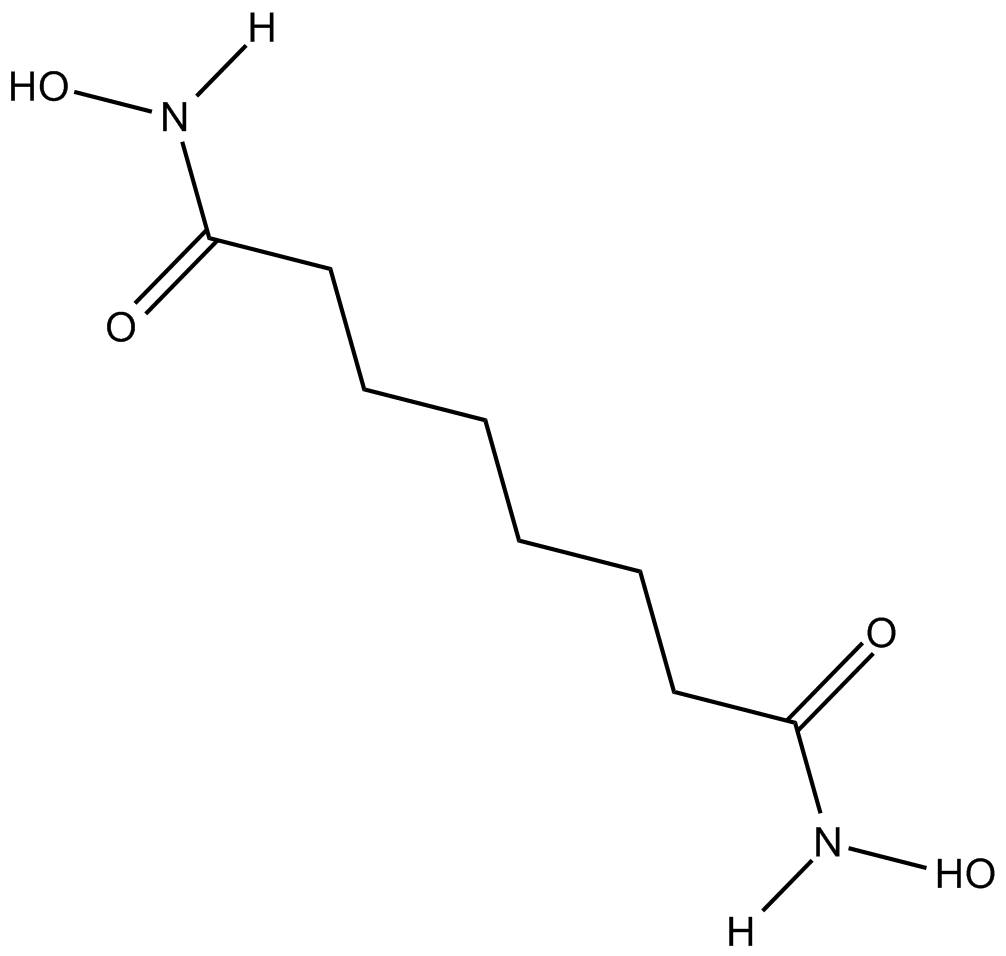Suberohydroxamic Acid (Synonyms: SBHA, Suberic bisHydroxamic Acid) |
| رقم الكتالوجGC12976 |
حمض سوبروهيدروكساميك (حمض سوبروهيدروكساميك ؛ SBHA) هو مثبط HDAC1 و HDAC3 تنافسي ومنفذ للخلايا مع قيم ID50 تبلغ 0.25 μ ؛ M و 0.30 μ ؛ M على التوالي. يمكن استخدام حمض سوبروهيدروكساميك لدراسة سرطان الغدة الدرقية النخاعي (MTC).
Products are for research use only. Not for human use. We do not sell to patients.

Cas No.: 38937-66-5
Sample solution is provided at 25 µL, 10mM.
Suberohydroxamic Acid (Suberoyl bis-hydroxamic acid, SBHA) is an inhibitor of HDAC with ID50 values of 0.25 and 0.30 μM for HDAC1 and HDAC3, respectively [1].
Histone deacetylases (HDACs) are a class of enzymes that remove acetyl groups from ε-N-acetyl lysines on histones, allowing the histones to wrap the DNA more tightly. DNA expression is regulated by de-acetylation and acetylation.
Suberohydroxamic Acid (SBHA) is an HDAC inhibitor. In MEL cells, SBHA induced the accumulation of acetylated H4 [1]. In medullary thyroid carcinoma (MTC) cells, SBHA dose-dependently induced the Notch-1 intracellular domain (the active form of Notch-1), which then decreased NE tumor marker chromogranin A (CgA) and achaete-scute complex-like 1 (ASCL-1), a downstream target of Notch-1 signaling. Also, SBHA increased the levels of cleaved poly ADP-ribose polymerase (PARP) and caspase-3, induced apoptosis and reduced cell viability in a dose-dependent way [2]. In MCF-7 breast cancer cells, SBHA induced the expressions of p53, p21, Bax, and PUMA, and ΔΨm collapsed, which then induced apoptosis [3]. In acute T lymphoblastic leukemia (T-ALL) cells, SBHA enhanced WNT/β-catenin signaling, blocked G2/M cell cycle progression, increased p21(WAF1) expression and inhibited cell growth. SBHA also increased the levels of cleaved PARP, caspase-9 and caspase-3, and induced apoptosis [4].
References:
[1]. Richon VM, Emiliani S, Verdin E, et al. A class of hybrid polar inducers of transformed cell differentiation inhibits histone deacetylases. Proc Natl Acad Sci U S A, 1998, 95(6): 3003-3007.
[2]. Ning L, Greenblatt DY, Kunnimalaiyaan M, et al. Suberoyl bis-hydroxamic acid activates Notch-1 signaling and induces apoptosis in medullary thyroid carcinoma cells. Oncologist, 2008, 13(2): 98-104.
[3]. Zhuang ZG, Fei F, Chen Y, et al. Suberoyl bis-hydroxamic acid induces p53-dependent apoptosis of MCF-7 breast cancer cells. Acta Pharmacol Sin, 2008, 29(12): 1459-1466.
[4]. Shao N, Zou J, Li J, et al. Hyper-activation of WNT/β-catenin signaling pathway mediates anti-tumor effects of histone deacetylase inhibitors in acute T lymphoblastic leukemia. Leuk Lymphoma, 2012, 53(9): 1769-1778.
Average Rating: 5 (Based on Reviews and 5 reference(s) in Google Scholar.)
GLPBIO products are for RESEARCH USE ONLY. Please make sure your review or question is research based.
Required fields are marked with *




















